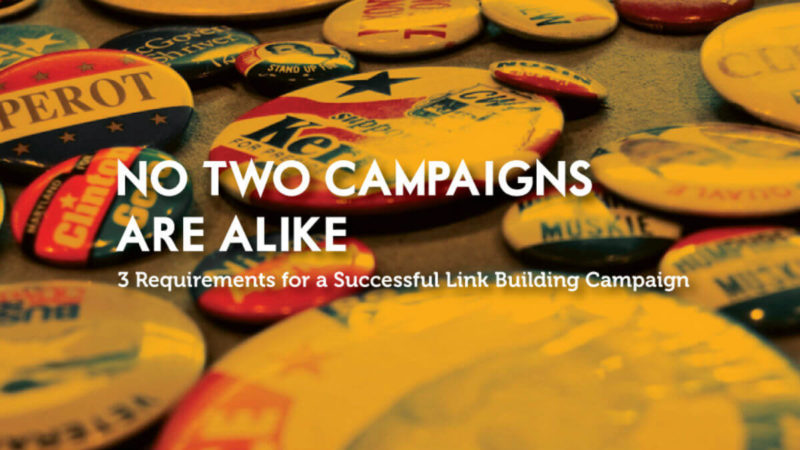

Link building campaigns are complex and nuanced. No two campaigns are alike, and tactics and strategies vary depending on the specific project.
Although every project is unique, there are three basic requirements that are essential to the success of any link building campaign.
- A genuinely useful product or service.
- Some form of quality content on the site.
- A willingness to collaborate and integrate.
If even one of these three critical pieces is missing, link acquisition becomes very difficult — and the entire project’s success is jeopardized.
Let’s dive deeper into each of these critical link campaign elements.
1. A Genuinely Useful Product Or Service
First and foremost, the company or client you’re building links for must have a genuinely useful product or service.
Link building isn’t magic, and the number one criterion for being link-worthy is having a useful product or service to offer. Providing value is crucial in nearly every aspect of link acquisition, and if the site you’re working with doesn’t offer some form of value to an existing audience, securing links will be extremely difficult.
Google values links because they signal trust, respect and authority. Links represent endorsements online, and nobody wants to endorse an disreputable brand or service.
Audience size can vary, as even the most obscure products or services will have people interested in them. What’s important is that a real audience exists; you can’t have an audience unless you’re offering something people want.
In fact, a really strong unique selling point (USP) or respected brand name can be an asset within the link campaign. If you have a popular product or a powerful brand name, chances are people are talking about it online, and you can convert those mentions into links.
Of course, if you don’t have a genuinely useful product or service, it’s likely you have problems beyond SEO and link building. But the number one, absolute requirement for an effective link acquisition project is to provide something people actually want or need.
2. Quality Content
Link campaigns cannot succeed without some form of quality content on the site.
There are definitely instances where it might be possible to build a few links without content (like the above example of turning an existing brand mention into a link). But for a sustainable, successful campaign, you need to have some form of quality content on your site.
But what does “quality” content mean? Any content that provides some form of value to your audience. Here are some different types of content that typically can be used as linkable assets:
- Unique research or data.
- Visually engaging images.
- Well-designed, thoroughly researched infographics.
- How-to articles/guides.
- Industry news coverage.
- Entertaining games or quizzes.
- Helpful tools.
- Instructional or amusing videos.
- High-profile interviews.
- Humorous or satirical material.
- Educational podcasts/webinars.
A simple blog can often be enough, as long as you’re creating content that’s designed to provide value for your target audience.
A common mistake many businesses and link builders make is focusing solely on product pages (or other converting pages). While these pages are important to you and your site, they’re usually not the most link-worthy. Other site owners don’t want to link to product pages; they want to link to interesting content that will offer value to their visitors.
Through sound internal linking, you can direct the flow of equity to your converting pages, but you need compelling content to acquire great links.
Great content alone isn’t enough, of course. You will still need manual, targeted promotion to secure all the links your content deserves. A study from BuzzSumo and Moz showed that simply creating quality content doesn’t translate to links — intentional promotion is still needed.
However, even the best promotion efforts will fall short if you don’t have content worth promoting.
3. Willingness To Collaborate
Finally, solid link campaigns require a client’s or company’s willingness to collaborate and integrate the campaign with other marketing initiatives.
Link building should never be a siloed strategy, performed in a vacuum from the rest of online marketing. Link acquisition often becomes exponentially more effective when integrated with other marketing efforts, such as:
- Content marketing.
- Public relations.
- Email marketing.
- Paid search.
- Social media marketing.
For example, a link campaign that follows in the wake of a successful publicity campaign can lead to tremendous success with brand mentions. Link building and content marketing also have a symbiotic relationship, as compelling content not only drives more links, but those links in turn improve the overall visibility (and therefore value) of that content.
Whether you’re an in-house SEO or a third-party vendor, you need buy-in from the marketing team to be effective. And you need clear, consistent communication to obtain buy-in.
If you can clearly explain how integration will help everyone succeed (and look good!), you’re much more likely to establish the trust needed for collaboration. You need to plainly demonstrate how links will support overarching marketing goals and objectives.
As an outside vendor, without collaboration and communication from your client, it becomes difficult to keep pace with their overall marketing goals and initiatives. You’ll miss important opportunities to leverage assets and initiatives if you don’t know they exist. Conversely, too much involvement from the client can hinder a campaign, primarily when the client places restrictions or constraints on the project.
Trust is a key ingredient in fostering collaboration with clients, other departments or other vendors. You must have an initial willingness to work together in order to execute a successful link campaign.
[Source:- searchengineland]
